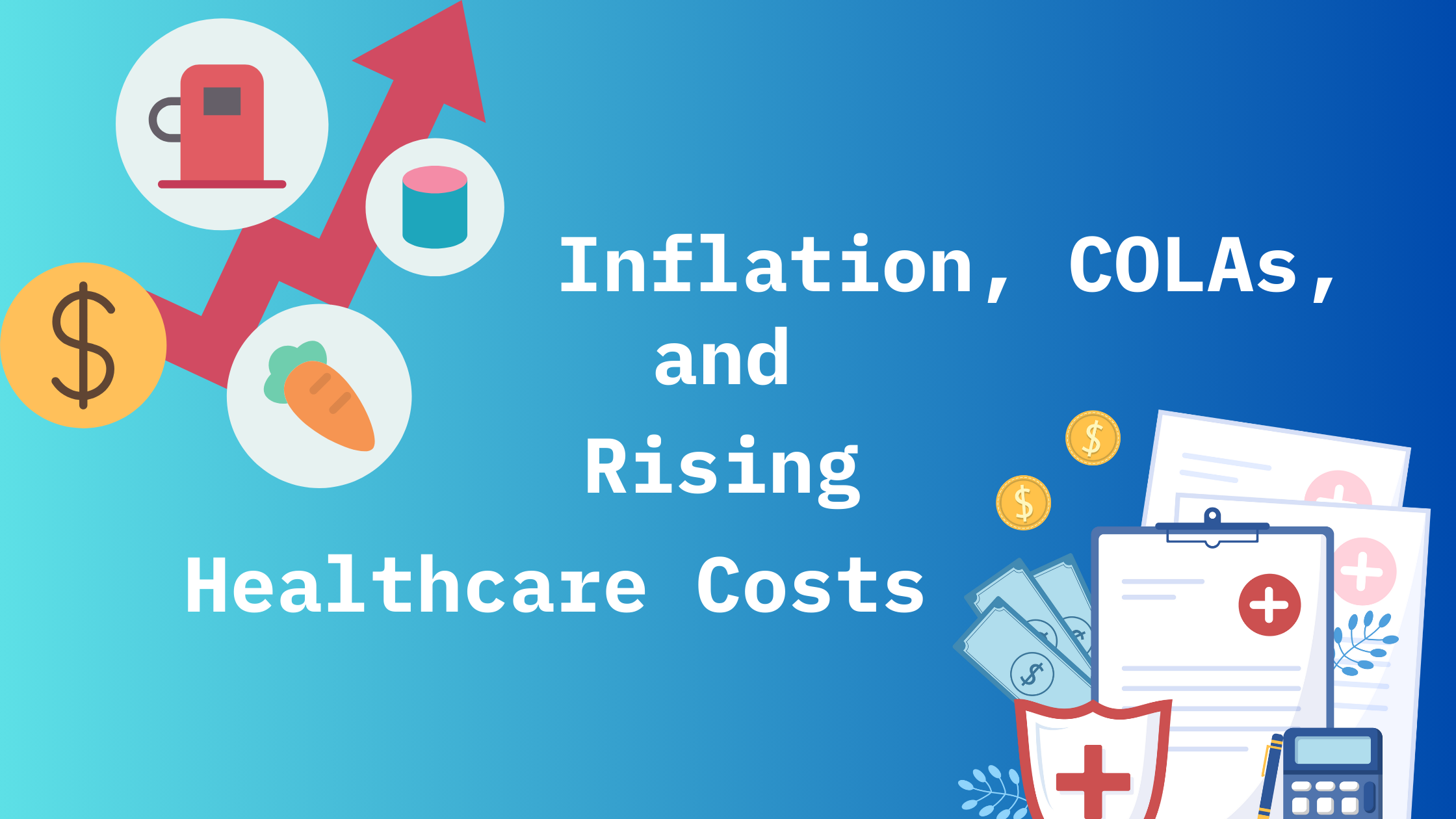Get an early 2026 COLA estimate & FEHB premium increase prediction. Will senior social security beneficiaries and CSRS and FERS retirees see a cost-of-living adjustment of 2.3%? Stay ahead of inflation!
2026 Social Security COLA Prediction vs. Anticipated FEHB Premium Increase
Federal retirees rely on social security Cost of Living Adjustments (COLAs) to keep pace with rising inflation. Both social security retirement benefits and federal pension income see automatic increases based on the average inflation as indicated by the Consumers Price Index (CPI). While this does help their finances to keep pace with the rising costs of basic needs, it does not take the skyrocketing cost of healthcare into account. This article will examine how previous COLA raises have stacked up against the average increase of FEHB (Federal Employee Health Benefits) premiums over recent years and then we’ll look ahead at 2026 predictions for each figure.
Recent COLAs’ Percent Increase and Average Premium Increases for Federal Health Benefit
| Year | Social Security and CSRS COLA | FERS COLA | FEHB Premium Increases (Avg.) | PSHB Premium Increase (Avg.) | Medicare B Premium Increase |
| 2022 | 5.9% | 4.9% | 3.8% | n/a | 14.5% |
| 2023 | 8.7% | 7.7% | 8.7% | n/a | -3.1% |
| 2024 | 3.2% | 2.2% | 7.7% | n/a | 5.9% |
| 2025 | 2.5% | 2.0% | 13.5% | 11.1% | 5.9% |
While the 5.9 percent in 2022 was more than the average FEHB increase, this has not been the case since. The official COLA of 8.7 percent in 2023 matched the increase. The past two years, however, the difference is significant, even reaching triple the amount last year. For USPS employees and retirees, the health premium increase from 2024 FEHB plans to comparable PSHB (Postal Service Health Benefits) plans was 2.0% less but still significantly higher than any COLAs received. The 2025 COLA announced by the social security administration (SSA) in October was 11 percent lower than the average premium increase for FEHB plans and 3.4 percent lower than the increase of Medicare B costs (which are taken directly from social security checks). This accentuates the fact that managing healthcare expenses has become a crucial component when developing a robust retirement and financial plan for federal retirees.
Meet with a Federal Retirement Expert, and learn what makes PlanWell Financial different from other firms.
Prediction for 2026 Increase of Social Security COLA
Social Security COLA 2026 projected to be lowest in recent memory. The prediction of the next COLA for social security benefits, as predicted by the senior citizens league, currently suggests a 2.4 percent increase. The adjustment for 2026 is now predicted to be .10 more than the April 2025 prediction of 2.3 percent. The SSA will publish the actual amount in October 2025. The new benefit amounts will then go into effect at the beginning of January 2026. Either a 2.3 or 2.4 percent COLA for those who receive social security benefits would mean a flat 2.0% cost-of-living adjustment for federal retirees receiving a FERS pension, although only retirees who are age 62 or older actually receive an adjustment to their FERS benefit.
Determining the Social Security Cost-of-Living Adjustment for 2026
The determination of the 2026 Social Security COLA is calculated based on the Consumer Price Index for Urban Wage Earners and Clerical Workers (CPI-W), which measures changes in the cost of goods and services. The Bureau of Labor Statistics plays a pivotal role in compiling this data. The COLA is designed to ensure that Social Security benefits keep pace with inflation, thereby preserving the purchasing power of retirees, but as shown above, the purchasing power is diminished by increasing healthcare costs. The 2026 COLA estimate is derived from the average CPI-W for the third quarter of 2025 compared to the same period in 2024. The new prediction of 2.4 percent is based on anticipated inflation numbers and is lower than 2025’s COLA of 2.5 percent but not by much.
Learn more about Social Security, the FERS pension, and the Thrift Savings Plan – Attend a Free Federal Retirement Webinar!
2026 COLA for CSRS, FERS, and Social Security Benefits
Social security recipients and federal annuitants can expect changes in their benefits based on the 2026 COLA. An increase in the COLA can result in higher monthly payments, helping beneficiaries cope with rising living costs, but might be offset by an increase in Medicare B expenses. The 2026 COLA is projected to be the lowest since 2021, which could pose challenges for seniors who rely heavily on Social Security and Medicare. Understanding these potential changes is crucial for effective financial planning.
Next Year’s COLA Estimates for Federal Annuitants
The COLA increases for federal pensions are based off the what social security’s adjustment will end up being. CSRS pensions receive an identical increase while the FERS benefit is 1.0% less if the CSRS increase is 3.0% or higher. If between 2.0% and 3.0%, FERS pensions see an adjustment of a flat 2 percent. Therefore, if the current estimate for 2026 ends up being 2.4%, retirees covered by FERS who are 62 or older will see an adjustment of 2.0% for the second year in a row.
Subscribe to our newsletter and receive a free FERS Handbook (PDF)
How Do Prescription Drug Costs Affect the 2026 COLA?
Are Prescription Drug Costs Considered in COLA Calculations?
Prescription drug costs are a significant concern for many retirees, but they are not directly considered in COLA calculations. The CPI-W, which forms the basis for the COLA, does not specifically account for changes in prescription drug prices. However, rising drug costs can indirectly influence the overall inflation rate, thereby affecting the COLA. Retirees must be aware of this limitation and consider additional strategies to manage their healthcare expenses.
How Significant are Prescription Drug Costs for Retirees?
Prescription drug costs represent a substantial portion of healthcare expenses for retirees, often straining their fixed incomes. As drug prices continue to rise, many seniors find it challenging to afford necessary medications. This financial burden underscores the importance of the COLA in helping retirees maintain their standard of living. However, given the projected lower COLA for 2026, retirees may need to explore alternative solutions to manage their prescription drug costs effectively.
Reach Out to Us!
If you have additional federal benefit questions, contact our team of CERTIFIED FINANCIAL PLANNER™ (CFP®), Chartered Federal Employee Benefits Consultants (ChFEBC℠), and Accredited Investment Fiduciary (AIF) professionals. At PlanWell, we are federal employee financial advisors with a focus on retirement planning. Learn more about our process designed for the career fed.
Preparing for federal retirement? Check out our scheduled federal retirement workshops. Sign up for our no-cost federal retirement webinars here! Make sure to plan ahead and reserve your seat for our FERS webinar, held every three weeks. Want to have PlanWell host a federal retirement seminar for your agency? Reach out, and we’ll collaborate with HR to arrange an on-site FERS seminar.
Want to fast-track your federal retirement plan? Skip the FERS webinar and start a one-on-one conversation with a ChFEBC today. You can schedule a one-on-one meeting here.










